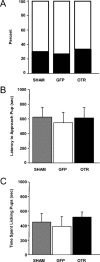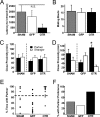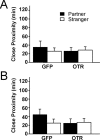Variation in oxytocin receptor density in the nucleus accumbens has differential effects on affiliative behaviors in monogamous and polygamous voles
- PMID: 19193878
- PMCID: PMC2768419
- DOI: 10.1523/JNEUROSCI.5039-08.2009
Variation in oxytocin receptor density in the nucleus accumbens has differential effects on affiliative behaviors in monogamous and polygamous voles
Abstract
Oxytocin receptors in the nucleus accumbens have been implicated in the regulation of alloparental behavior and pair bond formation in the socially monogamous prairie vole. Oxytocin receptor density in the nucleus accumbens is positively correlated with alloparenting in juvenile and adult female prairie voles, and oxytocin receptor antagonist infused into the nucleus accumbens blocks this behavior. Furthermore, prairie voles have higher densities of oxytocin receptors in the accumbens than nonmonogamous rodent species, and blocking accumbal oxytocin receptors prevents mating-induced partner preference formation. Here we used adeno-associated viral vector gene transfer to examine the functional relationship between accumbal oxytocin receptor density and social behavior in prairie and meadow voles. Adult female prairie voles that overexpress oxytocin receptor in the nucleus accumbens displayed accelerated partner preference formation after cohabitation with a male, but did not display enhanced alloparental behavior. However, partner preference was not facilitated in nonmonogamous meadow voles by introducing oxytocin receptor into the nucleus accumbens. These data confirm a role for oxytocin receptor in the accumbens in the regulation of partner preferences in female prairie voles, and suggest that oxytocin receptor expression in the accumbens is not sufficient to promote partner preferences in nonmonogamous species. These data are the first to demonstrate a direct relationship between oxytocin receptor density in the nucleus accumbens and variation in social attachment behaviors. Thus, individual variation in oxytocin receptor expression in the striatum may contribute to natural diversity in social behaviors.
Figures





Similar articles
-
RNAi knockdown of oxytocin receptor in the nucleus accumbens inhibits social attachment and parental care in monogamous female prairie voles.Soc Neurosci. 2015;10(5):561-70. doi: 10.1080/17470919.2015.1040893. Epub 2015 May 7. Soc Neurosci. 2015. PMID: 25874849 Free PMC article.
-
Increasing oxytocin receptor expression in the nucleus accumbens of pre-pubertal female prairie voles enhances alloparental responsiveness and partner preference formation as adults.Horm Behav. 2011 Nov;60(5):498-504. doi: 10.1016/j.yhbeh.2011.07.018. Epub 2011 Aug 7. Horm Behav. 2011. PMID: 21851821 Free PMC article.
-
Trichostatin A (TSA) facilitates formation of partner preference in male prairie voles (Microtus ochrogaster).Horm Behav. 2016 May;81:68-73. doi: 10.1016/j.yhbeh.2016.04.001. Epub 2016 Apr 10. Horm Behav. 2016. PMID: 27074037 Free PMC article.
-
The ties that bond: neurochemistry of attachment in voles.Curr Opin Neurobiol. 2016 Jun;38:80-8. doi: 10.1016/j.conb.2016.04.011. Epub 2016 Apr 30. Curr Opin Neurobiol. 2016. PMID: 27131991 Free PMC article. Review.
-
Sex-specific and social experience-dependent oxytocin-endocannabinoid interactions in the nucleus accumbens: implications for social behaviour.Philos Trans R Soc Lond B Biol Sci. 2022 Aug 29;377(1858):20210057. doi: 10.1098/rstb.2021.0057. Epub 2022 Jul 11. Philos Trans R Soc Lond B Biol Sci. 2022. PMID: 35858094 Free PMC article. Review.
Cited by
-
Oxytocin increases eye-gaze towards novel social and non-social stimuli.Soc Neurosci. 2019 Oct;14(5):594-607. doi: 10.1080/17470919.2018.1542341. Epub 2018 Nov 4. Soc Neurosci. 2019. PMID: 30378456 Free PMC article. Clinical Trial.
-
Behavioral characteristics of pair bonding in the black tufted-ear marmoset (Callithrix penicillata).Behaviour. 2012;149(3-4):407-440. doi: 10.1163/156853912X638454. Behaviour. 2012. PMID: 30504964 Free PMC article.
-
Multi-Level Effects Driving Cognitive and Behavioral Variability among Prairie Voles: Insights into Reproductive Decision-Making from Biological Levels of Organization.Brain Behav Evol. 2022;97(3-4):225-240. doi: 10.1159/000522109. Epub 2022 Jan 20. Brain Behav Evol. 2022. PMID: 35051922 Free PMC article. Review.
-
Separation anxiety, attachment and inter-personal representations: disentangling the role of oxytocin in the perinatal period.PLoS One. 2014 Sep 17;9(9):e107745. doi: 10.1371/journal.pone.0107745. eCollection 2014. PLoS One. 2014. PMID: 25229827 Free PMC article.
-
Dynamic corticostriatal activity biases social bonding in monogamous female prairie voles.Nature. 2017 Jun 8;546(7657):297-301. doi: 10.1038/nature22381. Epub 2017 May 31. Nature. 2017. PMID: 28562592 Free PMC article.
References
-
- Bales KL, Carter CS. Sex differences and developmental effects of oxytocin on aggression and social behavior in prairie voles (Microtus ochrogaster) Horm Behav. 2003;44:178–184. - PubMed
-
- Curtis JT, Wang Z. Ventral tegmental area involvement in pair bonding in male prairie voles. Physiol Behav. 2005a;86:338–346. - PubMed
-
- Curtis JT, Wang Z. Glucocorticoid receptor involvement in pair bonding in female prairie voles: the effects of acute blockade and interactions with central dopamine reward systems. Neuroscience. 2005b;134:369–376. - PubMed
-
- Dantzer R, Bluthe RM, Koob GF, Le Moal M. Modulation of social memory in male rats by neurohypophyseal peptides. Psychopharmacology. 1987;91:363–368. - PubMed
Publication types
MeSH terms
Substances
Grants and funding
LinkOut - more resources
Full Text Sources
